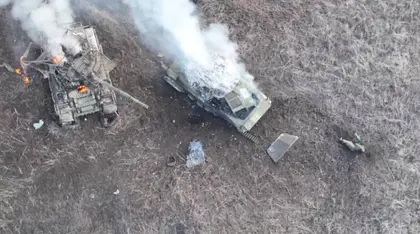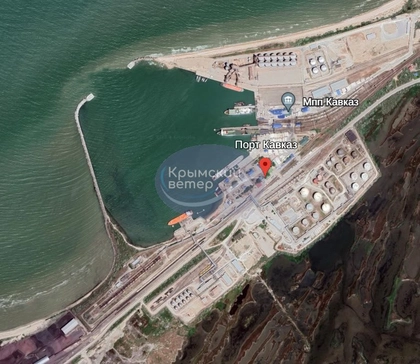At the end of two years of conventional war, the fact that the Ukrainian army is able to shoot the Kremlin’s museum pieces to bits is not exactly the worst news, for what was once the biggest and most intimidating fleet of armored combat vehicles on Earth. The real problem is the drones.
During a Feb. 17 attack, about 20 Cold War era Russian T-55 and T-62 tanks rumbled north as the steel spear tip of massed assault against the village of Robotyne, the Armed Forces of Ukraine (AFU) front-line position in the southern Kherson sector. What followed was witnessed on geo-located drone video and subsequent “after action reports.”
JOIN US ON TELEGRAM
Follow our coverage of the war on the @Kyivpost_official.
The assault tactics across open ground, by massed Cold War-era tanks, would have been familiar to Israeli or Syrian soldiers fighting on the Golan Heights in 1973. This attack was led by the men and machines from Russia’s 42nd Motorized Rifle Division.
Ukrainian FPV drones carrying anti-tank munitions swooped down on the Russian column as it was still two or three kilometers distant, targeting the relatively thin armor on the tank’s turret roofs and engine decks.
Next, using defensive tactics now commonly adopted across AFU units, weapons operators from the 65th Mechanized Infantry Brigade hit the Russian assault group with artillery-fired cluster munitions and anti-tank missiles. This halted the groups armored vehicles, with its infantry taking shelter in trenches and shell craters, only to be finished off by more kamikaze drones circling overhead. News reports led by Forbes magazine painted the incident in detail.

Anti-Kremlin Militia’s ‘Baba Yaga’ Drones Destroy Russian Observation Post in Belgorod
In a Feb. 20 engagement, across similar ground, and recorded by a defending drone operator unit called Spartan, a column of eight Russian armored vehicles, led by T-55s advanced. Apart from the anti-drone screens fitted above their turrets, these tanks were identical to the T-55 tanks sent by Soviet Union to invade Hungary in 1956. Battle was joined in fields near a village called Novomyhailivka where the tanks were again cut to pieces by kamikaze quadcopters deftly flown into the tanks’ side armor.
President Vladimir Putin and the Kremlin information machine have, over the past 24 months, treated tank losses at battles like Robotyne as an insignificant blip that the Russian military-industrial complex will bury in massed production.
According to Moscow’s slick state media reports, although avoiding giving any specific numbers, Russian industry is cranking out far more tanks every month, than Ukrainian soldiers in units like the 65th Brigade or the Spartan drone unit can collectively destroy. TV coverage of visit to a major tank factory in Nizhny Tagil by President Putin, on Feb. 15, the Russian leader shook hands with workers and smiled with approval at a modern T-90M tank under assembly.
Putin told the cameras that he Russian army is being fully equipped with modern fighting vehicles, and the historical centerpiece of Russian military might, its tanks, are being manufactured at five-times pre-war levels.
But independent observers and military analysts, particularly in Ukraine where most of the Russian tanks are supposedly destined, point to the continued presence of 70-year-old tanks on the battlefield. This is seen as only one of several indicators that over the past 24 months far more Russian tanks have been destroyed in combat in Ukraine, than Russia can make good, no matter what Russian state television and Putin claim.
According to figures quoted on Feb. 21 by Oryx, an open-source research group that uses independently verified photographs or video to count wartime casualties since the start of the war, the Russian Federation has lost 2,754 tanks. Since not everything destroyed or knocked out has an image of it on the internet, the real number is unquestionably greater.
Statistics published by Ukraine’s Army General Staff on Feb. 22, compiled by kills confirmed by video or photographs recorded by Ukrainian troops in the field, put the number of Russian tanks eliminated by all means at 6,523 combat vehicles.
Some independent observers have suggested that kill count is inflated by 10 to 20 percent, while others consider it to be heavily overstated. An estimate published by the British Defense Ministry on Jan. 29 put Russian tank losses at 2,600 vehicles. A Raytheon briefing published on Feb. 17 set the number at 2,402 tanks.
“Russia probably can generate at least 100 MBTs a month and therefore retains the capacity to replace battlefield losses and continue this (relatively limited) level of offensive activity,” the British Intelligence report said.
Almost all independent observers support the view that Russia is capable of fielding slightly more than 100 replacement tanks a month, and that is probably sufficient. Some of these vehicles may be top-of-the-line T-90s but more, overhauled T-72s, and increasingly obsolete T-62s and T-55s taken out of mothballs reaching the front every 30 days or so. Some estimates say that, provided that there are no major battles, that vehicle mix will allow the Kremlin to match ongoing losses and avoid running out of tanks.
In its 2024 Military Balance review, the International Institute for Strategic Studies (IISS) estimated that, taking into account some 4-5,000 old tanks scattered about Russia and suitable for refurbishment or just transfer to battle from stock. At present loss rates the Kremlin can feed tanks into its war in Ukraine, at about one hundred refurbished or new vehicles a month, for as much as the next three years.
But others question the Russian state’s ability to keep up its tank numbers. Ukraine claims that its strike drone manufacturers are, according to open sources, currently producing between 5-10,000 aircraft capable of toting anti-tank munitions every month. According to Ukrainian President Voldymyr Zelensky eight to ten times that many strike drones, each costing about $500 and capable of taking out a $2 million T-90M, will be in UAF hands by the end of 2024.
Strike drones are now so common in the AFU, dozens of battle reports say, that in major battles defending units often have three or more aircraft circling overhead awaiting a target to attack, much like an air support strike tactics favored by NATO militaries.
On Feb. 4 – more than a month into the current halt to US arms deliveries, amidst a shell shortage reducing some Ukrainian artillery batteries to five rounds or less a day – the Russian army suffered its reported second or third worst day of the entire war, in terms of tank losses across the entire front.
The previous one day kill record, reputedly 120 tanks, was set in early March 2022 when Russian tank columns stalled on roads to Kyiv, got hit with massed artillery barrages and modern anti-tank missiles dropped by plane-sized drones or fired by infantry teams.
Two years later, Russian tanks are dying differently. In battlefield video after battlefield video Russia’s tanks whether T-55 or T-90M all appear to end their service lives in a much different, perhaps more modern, way. Tiny FPV drones crash into the tank, one after another, until the tank stops and catches on fire. The AFU count on Feb. 4 was 55 Russian tanks more than half the Russian Federation’s purported monthly output of all types.
A drone operator from the 46th Brigade, one of the Ukrainian units participating in that Feb. 4 battle, argued that the numbers are pretty simple. From the perspective of a soldier attacked by Russian tanks, there is an exponential increase in the numbers of Ukraine’s anti-tank drones, while Russian tanks are not. In the near future, he said, the Ukrainian battlefield will be one where rusting old Russian tanks will be overwhelmed by swarms of Ukrainian drones.
The soldier said on his Telegram channel “In Robotyne [Zaporizhzhia region], the enemy actively attacked with armored vehicles. He almost completely repeated past tactical mistakes…There were BMP-1 infantry fighting vehicles, and T-55 and T-62 tanks deployed. In the past, (the Russians) had used such tanks for firing from protected positions (like artillery), because their armor is inadequate to protect them against anti-tank weapons and FPV-drones. This indicates either a reduction in (Russian) tank reserves…Or a very cynical approach (by Russian commanders)- why send new equipment to the attack if a tank can’t live on the battlefield for more than an hour?”
You can also highlight the text and press Ctrl + Enter






